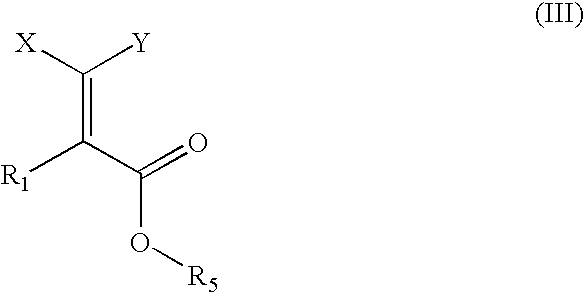Compounds, their preparation and use
a technology of n(2benzoylphenyl)l and tyrosine derivatives, which is applied in the field of new vinyl n(2benzoylphenyl)l tyrosine derivatives, can solve the problems of reducing the concentration of free fatty acids in plasma, not being strong enough, and not being beneficial to glycaemia in the fibrate class of compounds
- Summary
- Abstract
- Description
- Claims
- Application Information
AI Technical Summary
Problems solved by technology
Method used
Image
Examples
example 1
General Procedure (A)
(E)-(S)-2-(2-Benzoyl-phenylamino)-3-[4-(3-biphenyl-4-yl-allyloxy)-phenyl]-propionic acid methyl ester
[0162]
Step C:
[0163]Under an atmosphere of nitrogen, azodicarboxylic dipiperidide (620 mg, 2.5 mmol) was added at 0–5° C. to a stirred solution of (S)-2-(2-benzoyloxy-phenylamino)-3-(4-hydroxyphenyl)-propionic acid methyl ester (470 mg, 1.25 mmol), (E)-3-(4-biphenylyl)-2-propen-1-ol (260 mg, 1.25 mmol) and tributylphosphine (500 mg, 2.5 mmol) in dry THF (50 ml). The mixture was stirred over night. The reaction mixture was diluted with water and the product extracted with ethyl acetate. The organic layers were combined, washed with water, dried (MgSO4) and evaporated. The crude product was then purified by column chromatography on silica (eluent: 25% ethyl acetate in heptane) to give 420 mg (60%) of the title compound.
[0164]1H NMR (CDCL3): δ3.12 (1H, dd), 3.23 (1H, dd), 3.68 (3H, s), 4.40 (1H, q), 4.65.(2H, d), 6.40 (1H, dt), 6.55 (1H, t), 6.65 (1H, d), 6.73 (1H, d...
example 2
General Procedure (C)
(E)-(S)-2-(2-Benzoyl-phenylamino)-3-[4-(3-biphenyl-4-yl-allyloxy)-phenyl]-propionic acid
[0165]
Step A:
[0166](E)-(S)-2-(2-Benzoyl-phenylamino-3-[4-(3-biphenyl-4-yl-allyloxy)-phenyl]-propionic acid methyl ester (example 1) (400 mg, 0.7 mmol) was dissolved in a mixture of ethanol (15 ml) and THF (15 ml). 1N NaOH (3 ml) was added and the mixture was stirred for 1 h at room temperature. The mixture was concentrated in vacuo. Water (5 ml) and ethyl acetate (10 ml) was added. The mixture was neutralised with 1N HCl. The aqueous phase was isolated and extracted with ethyl acetate (×2) The organic layers were combined, washed with water, dried (MgSO4) and evaporated to give 400 mg of the title compound.
[0167]1H NMR (CDCl3): δ 3.15 (1H, dd), 3.30 (1H, dd), 4.40 (1H, bs), 4.64 (2H, d), 6.42 (1H, dt), 6.57–6.77 (3H, m), 6.88 (2H, d), 7.23 (2H, d), 7.30–7.62 (17H, m), 8.88 (1H, bs).
example 3
General Procedure (A)
(E)-(S)-2-(2-Benzoyl-phenylamino)-3-{4-[3-(9H-fluoren-2-yl)-allyloxy]-phenyl}-propionic acid methyl ester
[0168]
Step A:
[0169]Triethyl phosphonoacetate (16.8 g, 75.0 mmol) was added at 0° C. over a period of 10 min. to a stirred suspension of sodium hydride (60% in oil, 2.05 g, 51.5 mmol) in dry toluene (200 mL). After stirring at 0° C. for 15 min. a solution of fluorine-2-carboxaldehyde (9.7 g, 50.0 mmol) in dry toluene / THF (1:1) (50 mL). After adding THF (100 ml), the mixture was slowly warmed to room temperature, and stirring continued for 24 h. The reaction mixture was quenched with ethanol (50 ml) and added water (300 ml). The aqueous phase was separated and further extracted with ethyl acetate (250 mL). The combined organic phases were washed with water (300 mL), dried (MgSO4), filtered and concentrated in vacuo. The product was purified by flash column chromatography to give 13.0 g (E)-3-(9H-fluoren-2-yl)-acrylic acid ethyl ester.
[0170]1H NMR (CDCl3): δ 1.3...
PUM
| Property | Measurement | Unit |
|---|---|---|
| pH | aaaaa | aaaaa |
| resistance | aaaaa | aaaaa |
| affinity | aaaaa | aaaaa |
Abstract
Description
Claims
Application Information
 Login to View More
Login to View More - R&D
- Intellectual Property
- Life Sciences
- Materials
- Tech Scout
- Unparalleled Data Quality
- Higher Quality Content
- 60% Fewer Hallucinations
Browse by: Latest US Patents, China's latest patents, Technical Efficacy Thesaurus, Application Domain, Technology Topic, Popular Technical Reports.
© 2025 PatSnap. All rights reserved.Legal|Privacy policy|Modern Slavery Act Transparency Statement|Sitemap|About US| Contact US: help@patsnap.com



